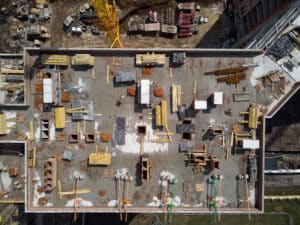
Equipment is the life blood of any construction company. It is the biggest line item on the balance sheet, essential to a timely and cost-effective completion of jobs, a major factor in the success of a company’s safety record, and the fastest way to grind projects to a halt when there are breakdowns.
With so much riding on the health and machine life of equipment, maintenance—especially preventative maintenance—is key to not only keeping machines operational but also extending their life, saving costs, maintaining safety standards, and avoiding costly rentals. Using technology to accomplish this makes the job easier and has added benefits.
Let’s discuss the top 5 equipment management challenges and how technology can help in conquering them:
- 1. Equipment Downtime
- 2. Costs
- 3. Complexity
- 4. Limited Resources
- 5. Safety
Equipment Downtime
Downtime is a major issue for construction companies, as it can result in delays, cost overruns, and lost productivity.
Some estimates suggest that the cost of equipment downtime can range from several thousand dollars per hour to tens of thousands of dollars per day. For example, a large crane may cost tens of thousands of dollars per day to rent, and a one-day delay in the project schedule could result in additional costs for labor, materials, and equipment.

In addition to the direct costs of equipment downtime, there may also be indirect costs, such as damage to the company’s reputation, lost future business opportunities, and reduced employee morale.
By using technology, construction companies can track the condition of their equipment in real-time and find potential problems before they become serious. Managing equipment maintenance effectively is critical to minimizing downtime and ensuring that equipment is available when it is needed.
Remote monitoring technology allows construction companies to track equipment usage and condition from a central location. This can help identify potential issues early and allow for quick action to prevent equipment downtime. Remote monitoring technology can also be used to optimize maintenance schedules, ensuring that equipment is serviced at the best time.
Data analytics technology can be used to review equipment data to find patterns and trends that can help predict when equipment is likely to fail. By identifying these trends early, construction companies can take proactive measures to prevent equipment downtime.
Many modern equipment management systems include automated alerting features that notify maintenance teams when equipment is due for maintenance or when potential issues are detected. This helps ensure that maintenance and repairs are carried out promptly.
By using these and other technology tools, construction companies can proactively find and address potential issues with their equipment, minimize unplanned downtime, and improve overall equipment reliability and uptime.
Costs
Maintaining equipment can be expensive, particularly for larger construction companies with large fleets of equipment. Balancing the cost of maintenance with the need to keep equipment in good condition can be challenging.
Technology can help construction companies optimize their maintenance schedules and reduce the frequency of costly repairs. Many of the benefits that prevent downtime also contribute to controlling and even lowering costs. In addition to those benefits, additional cost savings can be found in:
- Asset Tracking
Asset tracking technology can help construction companies keep track of their equipment and optimize their maintenance schedules. The added benefit of asset tracking is the ability to spot patterns of equipment use to recognize which types of equipment need more investment and which are seldom used and might be better rental options. - Condition-Based Maintenance
Condition-based maintenance technology uses real-time equipment data to schedule maintenance based on the actual condition of the equipment, rather than on a fixed schedule. This can help reduce the frequency of maintenance and repair visits, lowering costs. - Data Analytics
Data analytics technology can help construction companies identify trends and patterns in equipment data that can help optimize maintenance schedules and reduce costs. By analyzing data such as usage patterns, equipment performance, and maintenance history, companies can make better decisions about when to service their equipment.
Complexity
Construction equipment can be complex, with many different components that require maintenance and repair. Keeping track of all the parts, maintenance schedules, and repair records can be a significant challenge. 
Technology can be used to help construction companies keep track of inventory, schedules, and repair records both in the shop and office and out in the field. Equipment managers should seek the following types of solutions:
- Computerized Maintenance Management Systems (CMMS)
CMMS software can be used to manage maintenance schedules, track equipment usage, and store repair records in a centralized database. This can help ensure that maintenance and repairs are carried out on time, and that records are up-to-date and easily accessible. - Mobile Apps
Mobile apps can be used to track equipment usage, maintenance schedules, and repair records from the field. This can allow maintenance teams to quickly update records and access information on the go, improving efficiency and accuracy. - Barcoding, QR Codes, and RFID
Code and RFID technology can be used to track equipment and parts, making it easier to manage inventory and ensure that the right parts are available for maintenance and repairs. - Digital Documentation
Digital documentation, such as manuals, maintenance guides, and repair instructions, can be stored and accessed through online platforms, making it easier for maintenance teams to access the information they need and ensuring that everyone has access to the most up-to-date information.
By using these tools, construction companies can improve the accuracy and accessibility of their maintenance and repair records, ensuring that they have the information they need to manage their equipment effectively and efficiently.
Limited Resources
Many construction companies operate on tight budgets, which can limit their ability to invest in the technology and personnel needed to manage equipment maintenance effectively.
The most important technology for a construction company to invest in, even with limited resources, will depend on the specific needs and challenges of the company. One technology that can be particularly valuable for construction companies is CMMS.
When evaluating the investment in a CMMS, it’s important to factor in ROI to offset the overall costs. In addition to reduced downtime and improved maintenance and reliability:
- A CMMS can help to optimize maintenance activities, ensuring that labor resources are used efficiently and effectively. This can result in cost savings related to labor, equipment, and maintenance supplies.
- A CMMS can help ensure that maintenance activities are done in compliance with regulatory requirements and industry standards, reducing the risk of fines or legal issues.

Overall, a CMMS can provide significant ROI for companies by improving equipment reliability, reducing downtime, and optimizing maintenance activities. Many companies report seeing ROI within just a few months of implementing a CMMS, and the ongoing benefits can continue for years to come.
Safety
Safety is always a concern on construction sites, and poorly maintained equipment can pose a significant safety risk. Ensuring that equipment is well-maintained and safe to operate is critical to protecting workers and avoiding accidents.
Well-maintained equipment is less likely to fail or cause accidents, which can help improve safety on construction sites. Technology can also provide real-time data on equipment usage, allowing companies to monitor operator behavior and ensure that equipment is being used safely.
Overall, managing construction equipment maintenance is a complex and challenging task that requires careful planning, investment in technology and personnel, and a focus on safety and efficiency. By addressing these challenges proactively, construction companies can minimize downtime, reduce costs, and improve safety and productivity on their sites.
For more information, or to find out how a solution like Tenna can work for you, visit us now to book a demo and talk about your company’s needs.
Tenna is the only equipment management system built to solve construction challenges. Tenna users gain more control over resource management and better oversight for safety and compliance needs, and have full visibility over job costing, equipment utilization, and risk management without needing to interrupt the flow of work in the field. For more information, visit www.tenna.com.
